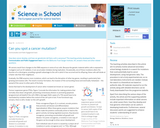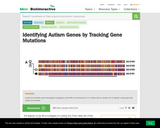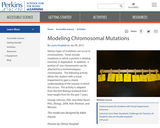
This webpage provides resources, including a link to an interactive resource, to aid student understanding of mutations in DNA.

This webpage provides resources, including a link to an interactive resource, to aid student understanding of mutations in DNA.

In this advanced lesson, students use amino acids sequences from the rock pocket mouse genome to illustrate the different levels of protein structure and the relationship between a protein's structure and function.

Although bioinformatics usually involves huge computers and sequencing machines, the methods of this new science can be presented by means of simple classroom activities to be carried out with pencil and paper. The author of this activity challenges us with the building of the family tree of humans and other primates on the basis of the genetic differences between short (fake) DNA sequences. The proposed activity can be profitably (and enjoyably) exploited in secondary schools to address some tricky biology topics such as the use of molecular clocks in the study of evolution.

This resource is a lab in which students are given a hypothetical DNA sequence for part of an enzyme. Using the universal genetic code, they will then determine the amino acid sequence coded for by the DNA. Differently shaped lego blocks will represent different amino acids. Students will construct the enzyme using legos.

The teaching activities in this article aim to actively involve students in a search for mutations that could potentially lead to cancer development, using real genomic data.

Students will learn how mutations can result in tumor heterogeneity and make tumors more sensitive or resistant to chemotherapy treatment. Students participating should have a basic understanding of cellular division (mitosis) and DNA structure and replication. Using this knowledge, students will run a tumor growth and treatment simulation to model how a tumor's heterogeneous composition can change the efficacy of chemotherapy treatment.

This lesson emphasizes the relationship between DNA sequences, mutations in DNA and the change in the resulting protein structure and function. Hemophilia A will be used as a real life example of how a mutation in DNA results in a change in a protein's structure and resulting ability to function. In order to complete these activities, the students should have prior knowledge in DNA structure and mutations, protein synthesis, Mendelian genetics and sex-linked traits.

This activity serves as an extension to the HHMI short film The Making of the Fittest: Natural Selection and Adaptation and a means of reinforcing the concepts of variation and natural selection. Students will examine 8 snapshot samples from rock pocket mouse populations (4 snapshots at each of 2 different locations). By counting the number of light and dark-colored mice present at each location, they will determine the correct order of the snapshots from oldest to most recent. They will then graph their results and write a scientific summary describing one of the mouse populations and how it has changed over time.

Students will complete a virtual lab on DNA mutations. Mutations involve a physical change to genetic material that results in the abnormal encoding of protein sequences. The students will complete mRNA and protein sequences based on the information provided. The students will identify the number of amino acids changed and how they think this mutation will impact the organism.

This online tutorial explores these key questions: How does DNA encode the characteristics of an organism?; In what different ways can mutations affect an organism?; How can a simple mutation end up having a major effect on the phenotype of an organism?; What does it mean to say that mutations are random?

This brief video clip discusses how reactive molecules, such as free radicals, and solar radiation can lead to mutations in DNA.

Students read an article describing a study that sheds new light on Charles Darwin's hobby of breeding pigeons. They learn about the origins of genes responsible for certain traits in pigeons, explore how scientists unravel the connections between genes and physical characteristics, and simulate a selective breeding program.

In this lesson, students will engage in an evolution card game to investigate how selective pressures can affect an organism's evolution.

This brief video describes the five ways that evolutionary change can occur. Assessments for the student to complete after viewing the video are also included.

This lesson focuses on how cancer is caused by mutations that accumulate over time in cells' DNA, how the genes mutated in cancer are involved in normal cell growth & division, and how different types of mutations affect the functions of these genes.

In this activity, students review research where scientists studied the genetic origin of variation in human skin color using a model organism, the zebrafish. Students will analyze histograms and then answer a series of questions to better understand mutations.

This news brief from April 2007 describes the genetics of lactose intolerance and how the trait is expressed in various human populations. This article includes a set of discussion and extension questions for use in class. It also includes hints about related lessons that might be used in conjunction with this one.

In this exercise, students will explore how a single alteration in the amino acid sequence of the hemoglobin protein results in sickle cell anemia.

In this activity, students study a family pedigree and a map of single nucleotides polymorphisms along one arm of a chromosome for each of the family members in order to better understand how a mutation in a single gene is the likely cause of the disorder.

In this activity, students use numbered cards to represent genes and demonstrate the four types of chromosomal mutations.